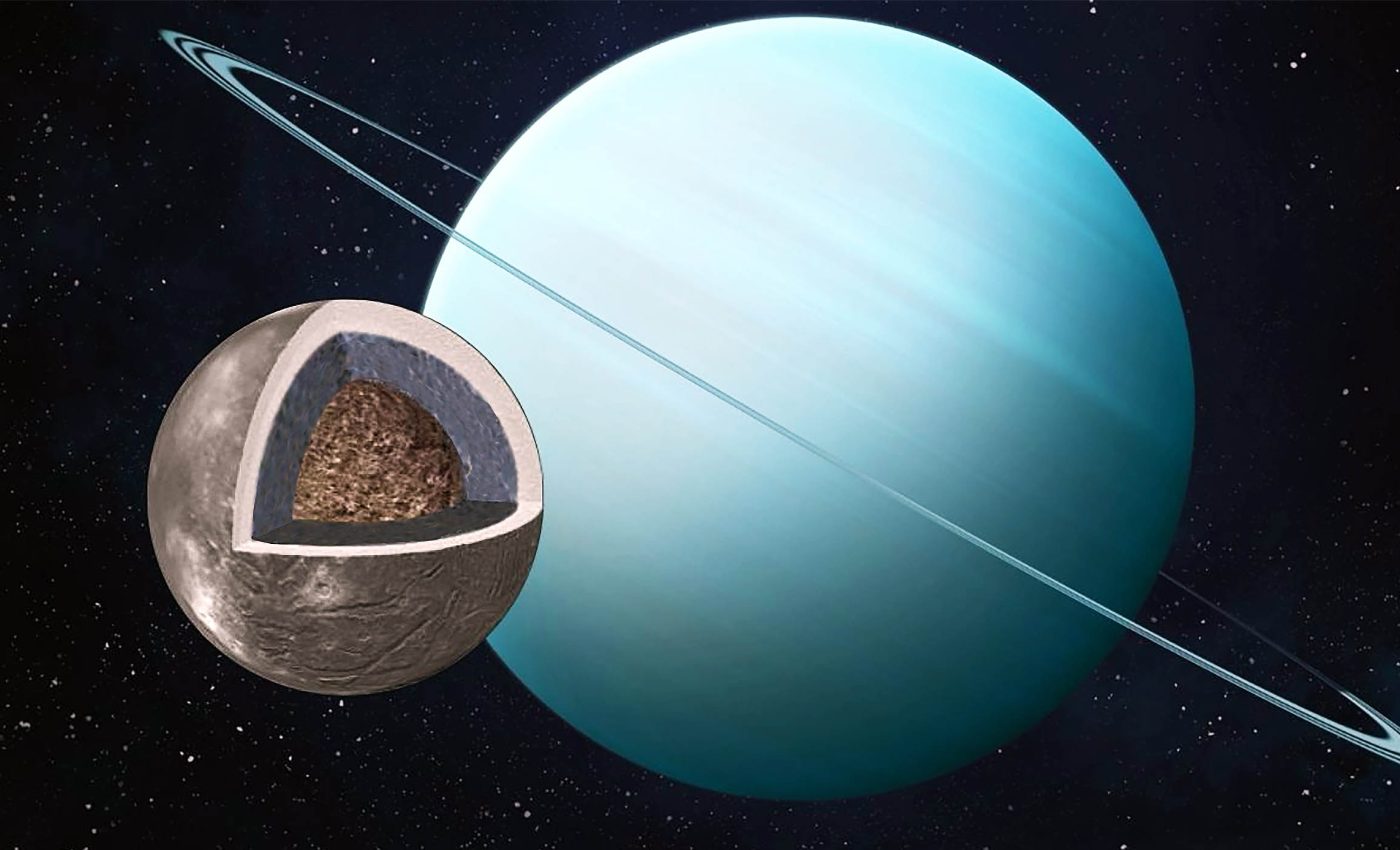
Another moon in our solar system may have an ocean up to 100 miles deep
A recent study concludes that Uranus’s moon Ariel likely carried a deep, hidden ocean, and that its orbit once stretched enough to split the surface.
The analysis ties a pattern of fractures and smooth plains to water under ice and to orbital tugging that loaded the crust until it failed.
The modeling points to an orbital eccentricity near 0.04 and a water layer close to 100 miles deep. That combination can apply enough stress to break ice and resurface parts of the moon within geologically recent time.
Ariel’s ocean beneath an icy shell
Voyager 2 images show a world of intersecting valleys and long chasms that cut through older craters. These cuts are grabens, blocks of crust that drop down between parallel faults.
The smoother plains nearby likely formed through cryovolcanism, where slurries of water and other volatiles erupted and spread across low areas.
The mix of very old and very young terrain hints at a long, stop and start geologic history. Only the southern hemisphere has been imaged in detail, so the full global pattern remains incomplete.
A value of eccentricity near 0.04 means Ariel’s orbit was modestly off a circle. That small offset can greatly increase how much the moon flexes during each trip around Uranus.
When the researchers matched stress maps to the orientations of faults and ridges, the predicted hotspots lined up with major fracture belts.
Stresses strong enough to crack ice emerged in regions that look disturbed in the Voyager mosaics.
The same set of runs favored a water layer on the order of 100 miles in thickness beneath a relatively thin ice shell. With ice that thin above liquid, fractures can propagate and reach the surface.
Tides that warm Ariel
Tidal stress is the push and pull caused by changing gravitational forces across a body. As Ariel moved slightly closer and farther during each orbit, the strength of that pull changed with time and location.
Repeated flexing turns orbital energy into internal heat. That heat can melt parts of the interior, thin the ice shell, and keep a subsurface ocean liquid far from sunlight.
If the flexing eases as the orbit circularizes, the water layer can cool and freeze from the top and bottom. That shift can leave behind a fossil pattern of fractures and smooth patches.
When Ariel’s ocean froze
Estimating when Ariel’s ocean existed is difficult because its surface shows both ancient and relatively young regions. The fractures, plains, and cryovolcanic flows overlap in ways that blur the timeline.
Researchers suggest that the most recent resurfacing likely occurred within the past one to two billion years, during a period of strong tidal heating when Ariel’s orbit was far more elliptical.
If this timeline is correct, Ariel’s ocean may have frozen gradually as its orbit stabilized and heat production dropped.
The remnants of that process could explain why ammonia and smooth plains still appear on the surface today, preserving the final traces of internal activity before the moon became geologically quiet.
Signs in Ariel’s ice
Near infrared spectra show ammonia compounds on Ariel’s surface. Ammonia degrades quickly under charged particle bombardment, so its presence points to a fresh supply from below.
Ammonia also lowers the freezing point of water, which helps liquid persist at colder temperatures. That chemistry supports the idea that Ariel’s interior once moved material to the surface.
Any lingering ocean would likely be a mixture of water and salts with dissolved ammonia. Such a solution would change how heat moves and how cracks grow through the ice.
Exploring Ariel’s ocean
The planetary decadal survey recommended a Uranus Orbiter and Probe as a top priority for the next large mission.
A dedicated tour could map the unseen northern hemispheres and test whether predicted fractures and ridges appear where models expect them.
“We are finding evidence that the Uranus system may harbor twin ocean worlds,” said Tom Nordheim of Johns Hopkins University Applied Physics Laboratory (JHUAPL), underscoring why a closer look matters.
“But either way, we need an ocean to be able to create the fractures that we are seeing on Ariel’s surface,” said Dr. Alex Patthoff of the Planetary Science Institute (PSI). The case for an ocean also rests on fitting the observed cracks.
A mission would not just snap better pictures. It could measure gravity and magnetism to probe internal structure, sample surface composition at high resolution, and watch how the crust flexes during each orbit.
Models like these do more than explain old images. They turn surface scars into a record of the underground, which we can check with new data.
The study is published in Icarus.
—–
Like what you read? Subscribe to our newsletter for engaging articles, exclusive content, and the latest updates.
Check us out on EarthSnap, a free app brought to you by Eric Ralls and Earth.com.
—–













